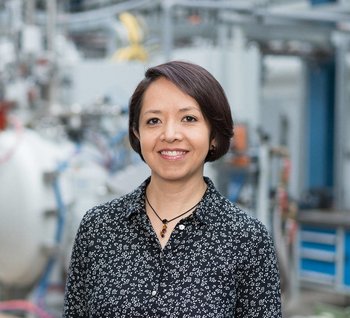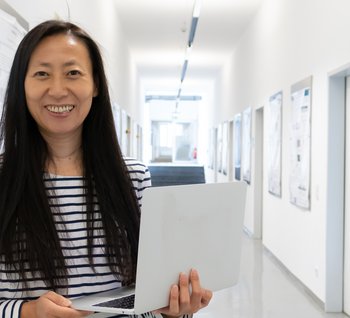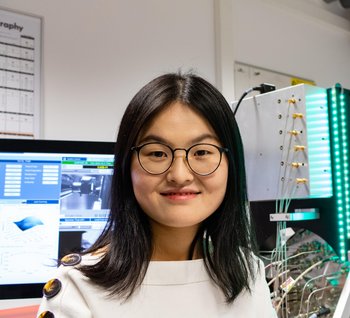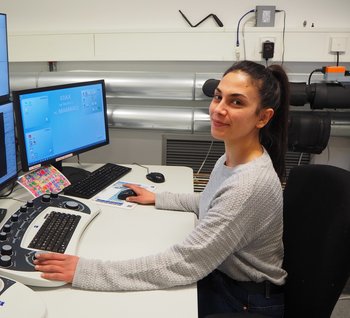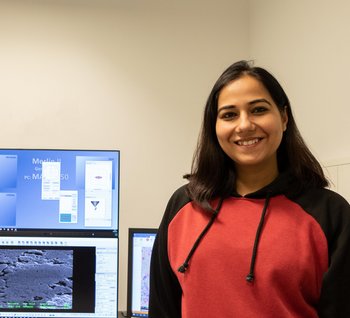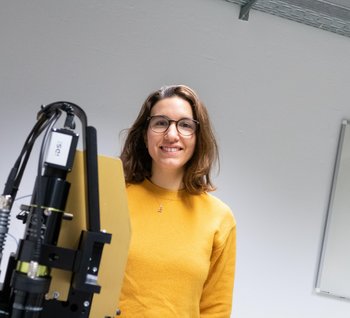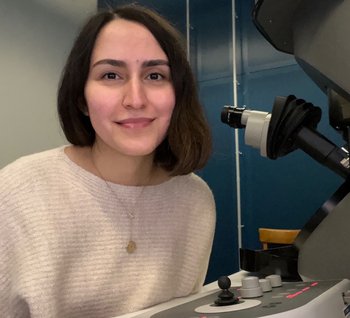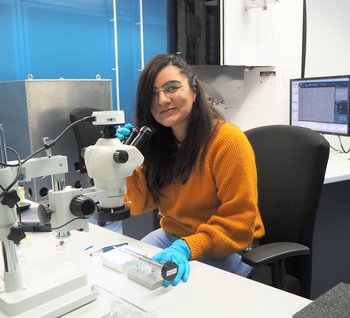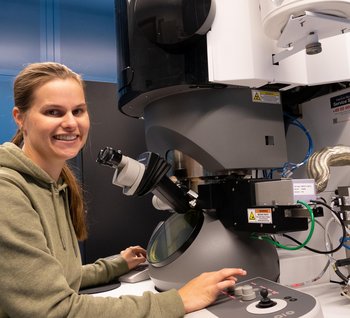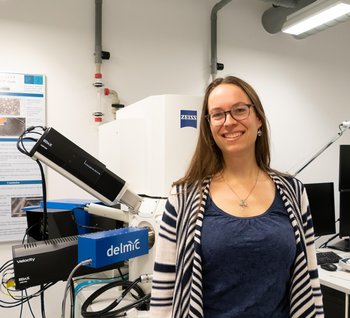Women in Science
Dr. Jazmin Duarte understands research in this sense: “In the end, science is a team effort. Every scientific discovery carries the work of many researchers that put part of their life and expertise in it. So, every new concept, theory or mechanism discovered, as insignificant we might think it is at some point, could play an important role in the bigger picture”, she explains. One such scientist who has especially inspired Duarte is Marie Curie. Not only because of her ground-breaking findings in a field dominated by men, but also her service for the people: “During war, she travelled to the field hospitals with her self-developed mobile X-ray unit. She used her scientific discoveries to help others. This is something I really admire.”
Research for Duarte becomes especially relevant, when it is put in to the service of the people: “Science has improved our quality of life with every new discovery. Improvements in medicine help us to live longer and healthier. Improvements in electronics allow us to connect with people around the world and improvements in structural materials make longer flights without the need of refuelling mid-flight possible”, says Duarte. With all these advances in mind she also sees the protection of the environment as a service to the people. Every scientific improvement therefore needs to be considered through the lens of its ecological effects thus bearing a responsibility regarding future research.
Sustainability is a big topic at MPIE and one Duarte is also working on. Particularly the effects of hydrogen on the mechanical behaviour of materials. Hydrogen can be used as a clean energy carrier but also degrades certain materials leading to fracture. The goal of her and her colleagues is to use the understanding of hydrogen effects to design materials more resistant, sustainable and safe. Her insights may also be part of a bigger picture assembled by generations of scientists to come: “Of course in this future generation of scientists we also need more women. Science can be so much fun when approached with an open mind for discovery and learning. I can only say to girls who are curious about science: Approach female scientists you might know, at places like MPIE or science fairs. We are friendly people and open to answer all your questions.”
Research for Duarte becomes especially relevant, when it is put in to the service of the people: “Science has improved our quality of life with every new discovery. Improvements in medicine help us to live longer and healthier. Improvements in electronics allow us to connect with people around the world and improvements in structural materials make longer flights without the need of refuelling mid-flight possible”, says Duarte. With all these advances in mind she also sees the protection of the environment as a service to the people. Every scientific improvement therefore needs to be considered through the lens of its ecological effects thus bearing a responsibility regarding future research.
Sustainability is a big topic at MPIE and one Duarte is also working on. Particularly the effects of hydrogen on the mechanical behaviour of materials. Hydrogen can be used as a clean energy carrier but also degrades certain materials leading to fracture. The goal of her and her colleagues is to use the understanding of hydrogen effects to design materials more resistant, sustainable and safe. Her insights may also be part of a bigger picture assembled by generations of scientists to come: “Of course in this future generation of scientists we also need more women. Science can be so much fun when approached with an open mind for discovery and learning. I can only say to girls who are curious about science: Approach female scientists you might know, at places like MPIE or science fairs. We are friendly people and open to answer all your questions.”
One could see Zhu’s way into science as a logical consequence: “For me entering the field of research is more or less related to my personality. The exploration in the scientific field is like climbing a mountain. The kind of mountain with many peaks, each climb to the top of a peak gives you a small sense of conquest. This gives me a lot of joy.” Zhu explains. Her research mainly focus on three aspects: 1) investigating material properties using multi-scale simulation methods, 2) developing efficient methodologies that allow for high-throughput calculations in order to provide accurate thermodynamic database for material design, and 3) automatizing complex simulation protocols into easy-to-use tools. The overall goal is to speed up the novel material design and reduce computing cost for a sustainable environment.
The core of the simulation methods she employs is parameter-free ab initio calculation based on quantum mechanics. Using this method, the macroscopic properties of materials can be explained from the level of chemical bonding. Ab initio calculations have been traditionally limited to a temperature of 0 Kelvin, “When going up to finite temperatures, the computational cost becomes extremely expensive even with modern computing power. The Computational Materials Design department at MPIE is a world leading team in methodology development. It has established a methodology to break the temperature limit. Now we can accurately calculate the solid free energy up to the melting point with high efficiency”, says Zhu. On top the development of phase diagrams is critical for guiding material design. However, such calculations based on ab initio have been hindered in the past two decades due to the extreme computational cost. To tackle this challenge Zhu has developed a state-of-art methodology for liquid free energy calculations, which combines significantly improved computational efficiency and ab initio accuracy by employing machine learning potentials. Besides these scientific developments, she is also involved in the Platform MaterialDigital: A nation-wide initiative to develop infrastructure and software solutions for sharing data, workflows and knowledge by taking novel concepts as well as industrial needs into account.
Alongside digitalization and big data, another hot topic accompanies Zhu in her career: Reconciling work and family life. Zhu herself gave birth to her now 8-year-old son during her Postdoc: “Having a career in science is challenging and competitive, especially for women with small kids. Therefore, time management and good organization skills become extremely important in order to make a balance between work and private life. However, one can get lots of practical support from our institute that is greatly helpful.” Despite these challenges, Zhu would recommend choosing the scientific path: “Personally, I feel that working in the scientific field can not only train one's working ability, but also sharpen one's will. As for me, I am especially happy that I have spent quite a period at MPIE. Not only its advanced research environment, but also the warm and human culture will be a lifetime treasure for me. And even if you eventually decide to leave the scientific field, you will still benefit from what you have learned for the rest of your life.”
The core of the simulation methods she employs is parameter-free ab initio calculation based on quantum mechanics. Using this method, the macroscopic properties of materials can be explained from the level of chemical bonding. Ab initio calculations have been traditionally limited to a temperature of 0 Kelvin, “When going up to finite temperatures, the computational cost becomes extremely expensive even with modern computing power. The Computational Materials Design department at MPIE is a world leading team in methodology development. It has established a methodology to break the temperature limit. Now we can accurately calculate the solid free energy up to the melting point with high efficiency”, says Zhu. On top the development of phase diagrams is critical for guiding material design. However, such calculations based on ab initio have been hindered in the past two decades due to the extreme computational cost. To tackle this challenge Zhu has developed a state-of-art methodology for liquid free energy calculations, which combines significantly improved computational efficiency and ab initio accuracy by employing machine learning potentials. Besides these scientific developments, she is also involved in the Platform MaterialDigital: A nation-wide initiative to develop infrastructure and software solutions for sharing data, workflows and knowledge by taking novel concepts as well as industrial needs into account.
Alongside digitalization and big data, another hot topic accompanies Zhu in her career: Reconciling work and family life. Zhu herself gave birth to her now 8-year-old son during her Postdoc: “Having a career in science is challenging and competitive, especially for women with small kids. Therefore, time management and good organization skills become extremely important in order to make a balance between work and private life. However, one can get lots of practical support from our institute that is greatly helpful.” Despite these challenges, Zhu would recommend choosing the scientific path: “Personally, I feel that working in the scientific field can not only train one's working ability, but also sharpen one's will. As for me, I am especially happy that I have spent quite a period at MPIE. Not only its advanced research environment, but also the warm and human culture will be a lifetime treasure for me. And even if you eventually decide to leave the scientific field, you will still benefit from what you have learned for the rest of your life.”
This can cause catastrophic failure if not recognized early enough. So how does this embrittlement occur and what can we do to prevent it? This is a question Dr. Huan Zhao is working on at MPIE.
Hydrogen embrittlement: Causes and how to avoid it
She is working in the research group “Mechanism-based Alloy Design” on the harm-causing effects of hydrogen in aluminium alloys: “As hydrogen is the smallest of all elements, it is extremely challenging to detect on the atomic scale. Thanks to the new cryo-transfer atom probe tomography developed at MPIE, we were able to map the distribution of hydrogen and understand its influence on the mechanical properties”, explains Zhao. But what about completely avoiding the damage hydrogen can bring to alloys? Manipulating the hydrogen trapping sites to mitigate embrittlement is one promising solution researched by Zhao and her colleagues. What she furthermore explores is the specific corrosion behaviour of aluminium to enhance corrosion resistance and improve sustainability of engineering materials.
Behind the data
Digging into the mechanisms behind experimental data is key for Huan Zhao’s passion for her field: “Tracking and trapping hydrogen in alloys is like being a materials detective. And every contribution to the field boosts your confidence, because it is one step closer to improving safety for people in their daily lives.”
Hydrogen embrittlement: Causes and how to avoid it
She is working in the research group “Mechanism-based Alloy Design” on the harm-causing effects of hydrogen in aluminium alloys: “As hydrogen is the smallest of all elements, it is extremely challenging to detect on the atomic scale. Thanks to the new cryo-transfer atom probe tomography developed at MPIE, we were able to map the distribution of hydrogen and understand its influence on the mechanical properties”, explains Zhao. But what about completely avoiding the damage hydrogen can bring to alloys? Manipulating the hydrogen trapping sites to mitigate embrittlement is one promising solution researched by Zhao and her colleagues. What she furthermore explores is the specific corrosion behaviour of aluminium to enhance corrosion resistance and improve sustainability of engineering materials.
Behind the data
Digging into the mechanisms behind experimental data is key for Huan Zhao’s passion for her field: “Tracking and trapping hydrogen in alloys is like being a materials detective. And every contribution to the field boosts your confidence, because it is one step closer to improving safety for people in their daily lives.”
The big one: Climate change
Now the question is of course not what causes climate change, nor its catastrophic consequences but rather how to tackle it. We need to rethink our technology and way of life to reconcile our civilization with environment. One major topic has to be the production of steel - as without steel a modern civilization would not be thinkable: “The steel industry is very important but also the single biggest emitter of global CO2 emissions. So obviously we need new, more sustainable steel production”, explains Özgün. One possible alternative to the conventional steel production is the reduction of iron ores using hydrogen. This is well known, although some questions are still open that prevent the large-scale use of this technology: “The reactions of iron oxide with the impurities in the iron ore at the atomic scale are still not understood. However, this is a central question. Researching this question is my aim as member of our research group on Sustainable Metallurgy.”
A blind spot motivating Özgün. Not only because she is doing her part for the sake of fighting climate change as she explains: “One of the reasons that makes me highly interested about this research is, that the role of impurities in materials has been underinvestigated for a long time and there is no sufficient fundamental knowledge on this aspect.” And where to better research fundamentals than at the MPIE? “MPIE is a great institute that provides a good working environment with latest technology. Here is the best place for those who have a high curiosity about science!”, Özgün adds.
More questions waiting to be answered
There are still a lot of questions out there waiting to be answered by all those choosing the scientific path. Fundamental questions, which give us insights in natural processes or expand our problem-solving possibilities: “There is much to learn and much to uncover in the world around us. All young scientists need is curiosity and no fear to follow their dreams!”
Now the question is of course not what causes climate change, nor its catastrophic consequences but rather how to tackle it. We need to rethink our technology and way of life to reconcile our civilization with environment. One major topic has to be the production of steel - as without steel a modern civilization would not be thinkable: “The steel industry is very important but also the single biggest emitter of global CO2 emissions. So obviously we need new, more sustainable steel production”, explains Özgün. One possible alternative to the conventional steel production is the reduction of iron ores using hydrogen. This is well known, although some questions are still open that prevent the large-scale use of this technology: “The reactions of iron oxide with the impurities in the iron ore at the atomic scale are still not understood. However, this is a central question. Researching this question is my aim as member of our research group on Sustainable Metallurgy.”
A blind spot motivating Özgün. Not only because she is doing her part for the sake of fighting climate change as she explains: “One of the reasons that makes me highly interested about this research is, that the role of impurities in materials has been underinvestigated for a long time and there is no sufficient fundamental knowledge on this aspect.” And where to better research fundamentals than at the MPIE? “MPIE is a great institute that provides a good working environment with latest technology. Here is the best place for those who have a high curiosity about science!”, Özgün adds.
More questions waiting to be answered
There are still a lot of questions out there waiting to be answered by all those choosing the scientific path. Fundamental questions, which give us insights in natural processes or expand our problem-solving possibilities: “There is much to learn and much to uncover in the world around us. All young scientists need is curiosity and no fear to follow their dreams!”
A constellation awakening Khushubo Devi’s curiosity and fascination for the field: “After finishing my bachelor's degree, I wasn't sure if I wanted to pursue a career in science. However, while working on my master's thesis, I developed an interest in the burning issues of materials research. My heartfelt gratitude goes to my amazing professors as well as my parents. After that, during my PhD, I began to actually appreciate learning completely new topics from diverse fields.”, Devi says.
She joined the MPIE as a postdoctoral fellow of the Alexander von Humboldt Foundation in January and is working in the department of Microstructure Physics and Alloy Design. Her study is mostly focused on green steel production. “Researchers all across the world are looking for strategies to reduce CO2 emissions. The steel sector accounts for 8% of global emissions, and this figure is expected to rise further. Given the critical nature of climate change, we urgently require industrial-scale sustainable alternatives.”, Devi explains.
Her main focus is the reduction of iron ore under hydrogen atmosphere. This reduction process is known and promising, but certain fundamental concerns remain, for example about the processes at the microstructural and atomic scale during the reduction. Devi and her colleagues want to address these concerns: “The current working idea seeks to comprehend the precise kinetics of direct reduction of iron ore pellets by pure molecular hydrogen, followed by the intermediate production of additional iron oxide types. The findings will provide microstructural and atomic-scale insights into the composition and phase changes that occur during iron ore reduction by hydrogen using environmental in-situ TEM (note from the author: TEM: transmission electron microscope) studies, paving the way for a better understanding of the thermodynamics and kinetic barriers of this critical process”.
One of the motivations for joining the MPIE was its reputation as Devi states that "the Max Planck Society is widely renowned on the international stage for solving several significant scientific subjects. They develop a unique atmosphere where perspectives and ideas may be shared crossing cultures and ethnicities. Furthermore, MPIE has provided a plethora of inspiring personalities who have demonstrated their dedication to research in order to uncover something new.”
Devi herself does not have any female scientific role model. At the same time, she certainly considers her mother as a role model. Her mother has no formal education, however recognizing the importance of education. She always encouraged and supported Devi in her pursuit of further education and scientific progress: “While embarking on an unchartered path like research, it is necessary to keep an eye on your goal. It is not necessary to be exceptionally intelligent in order to tackle any outstanding topic in research. It requires a great deal of patience and continuous effort, as there are more failures than successes, which are the greatest teachers", concludes Devi.
She joined the MPIE as a postdoctoral fellow of the Alexander von Humboldt Foundation in January and is working in the department of Microstructure Physics and Alloy Design. Her study is mostly focused on green steel production. “Researchers all across the world are looking for strategies to reduce CO2 emissions. The steel sector accounts for 8% of global emissions, and this figure is expected to rise further. Given the critical nature of climate change, we urgently require industrial-scale sustainable alternatives.”, Devi explains.
Her main focus is the reduction of iron ore under hydrogen atmosphere. This reduction process is known and promising, but certain fundamental concerns remain, for example about the processes at the microstructural and atomic scale during the reduction. Devi and her colleagues want to address these concerns: “The current working idea seeks to comprehend the precise kinetics of direct reduction of iron ore pellets by pure molecular hydrogen, followed by the intermediate production of additional iron oxide types. The findings will provide microstructural and atomic-scale insights into the composition and phase changes that occur during iron ore reduction by hydrogen using environmental in-situ TEM (note from the author: TEM: transmission electron microscope) studies, paving the way for a better understanding of the thermodynamics and kinetic barriers of this critical process”.
One of the motivations for joining the MPIE was its reputation as Devi states that "the Max Planck Society is widely renowned on the international stage for solving several significant scientific subjects. They develop a unique atmosphere where perspectives and ideas may be shared crossing cultures and ethnicities. Furthermore, MPIE has provided a plethora of inspiring personalities who have demonstrated their dedication to research in order to uncover something new.”
Devi herself does not have any female scientific role model. At the same time, she certainly considers her mother as a role model. Her mother has no formal education, however recognizing the importance of education. She always encouraged and supported Devi in her pursuit of further education and scientific progress: “While embarking on an unchartered path like research, it is necessary to keep an eye on your goal. It is not necessary to be exceptionally intelligent in order to tackle any outstanding topic in research. It requires a great deal of patience and continuous effort, as there are more failures than successes, which are the greatest teachers", concludes Devi.
“I didn’t actively plan on going on this path. I remember that I was looking for a diploma thesis and I was offered one in materials science and I completely loved it. This investigation of the microstructure, composition and how a very small change will affect the thermomechanical properties, corrosion or the performance of the materials just kept me in.”
As technology advances there is a clear shift towards miniaturization as Bellón explains: “In materials sciences, there is what is called the size effect: The smaller the stronger, but even though this is known, there are still some gaps in understanding this in the context of extreme situations.” Therefore, Bellón's main research focus is to study the mechanical properties of nano- and microscaled materials in extreme conditions. Compressing different small-scale particles or pillars at very high speeds and through a wide range of temperatures. As not only the composition can impact materials' properties, but also the conditions to which they are subjected.
Her work is never the same, it is a continuous challenge, keeping Bellón busy. Finding the reasons for different behaviour, interpreting experiments, solving problems and creating experiments from scratch. And even if experiments do not work they still give her information about what is happening and she can test her ideas. Bellón appreciates this creative process and also the work environment at the MPIE: “Before applying here, I knew of the reputation and well name of the MPIE. I spoke with different colleagues that have worked here before or have tight relations with the institute and they recommend it to me. Here I can work independently but also together with colleagues in an international environment which is something I appreciate.”
In her scientific path, Bellón had no specific scientific role model, although meeting very amazing women in her career. In the materials department where she did her diploma thesis, the professors were only female and meeting more amazing women during her PhD inspired her to fight for what she wanted. This was something she learned from her mother, who has always been a great inspiration to her: “There is something my mom used to tell me: The one who wants is more able than the one who can. So don’t ever let anyone tell you what you cannot or should not do. That should come from your inner feelings." Bellón adds: "When you want to go into science I would also recommend to join supporting scientific women groups, where you can share your experiences and learn from others”.
As technology advances there is a clear shift towards miniaturization as Bellón explains: “In materials sciences, there is what is called the size effect: The smaller the stronger, but even though this is known, there are still some gaps in understanding this in the context of extreme situations.” Therefore, Bellón's main research focus is to study the mechanical properties of nano- and microscaled materials in extreme conditions. Compressing different small-scale particles or pillars at very high speeds and through a wide range of temperatures. As not only the composition can impact materials' properties, but also the conditions to which they are subjected.
Her work is never the same, it is a continuous challenge, keeping Bellón busy. Finding the reasons for different behaviour, interpreting experiments, solving problems and creating experiments from scratch. And even if experiments do not work they still give her information about what is happening and she can test her ideas. Bellón appreciates this creative process and also the work environment at the MPIE: “Before applying here, I knew of the reputation and well name of the MPIE. I spoke with different colleagues that have worked here before or have tight relations with the institute and they recommend it to me. Here I can work independently but also together with colleagues in an international environment which is something I appreciate.”
In her scientific path, Bellón had no specific scientific role model, although meeting very amazing women in her career. In the materials department where she did her diploma thesis, the professors were only female and meeting more amazing women during her PhD inspired her to fight for what she wanted. This was something she learned from her mother, who has always been a great inspiration to her: “There is something my mom used to tell me: The one who wants is more able than the one who can. So don’t ever let anyone tell you what you cannot or should not do. That should come from your inner feelings." Bellón adds: "When you want to go into science I would also recommend to join supporting scientific women groups, where you can share your experiences and learn from others”.
“Doing research makes me feel like I am a modern-day storyteller with the characters being my particles, tools and theories. Sometimes I feel like I am solving a riddle and that requires me to work on something for days but the moment that it is solved, that happy moment, is totally worth it.” says Changizi.
She works in the independent research group “Nanoanalytics and Interfaces” headed by Prof. Christina Scheu. There, Changizi analyses lanthanide doped semiconductors. As a physicist she was always intrigued by the physics behind the light. The particles that she studies have light-producing properties which she tries to enhance even more. The detailed microscopes at the institute enable Changizi and her colleagues to investigate the materials on the nanoscopic scale and check how the atoms behave and change in different conditions and determine which conditions are most favourable for applications in industry.
Coming back to inspiring stories and personalities: A great inspiration for Changizi comes from her group leader Prof. Christina Scheu: “Working with Tina is very pleasant and always engaging. Her love and dedication for science is beyond words. And this passion and energy spreads to all her students including me. I hope that one day I can be a kind and caring leader like her.” Going into science not only offered a career path but also personal development: “Personally speaking, doing science really boosted my confidence. It gave me the wings to be stronger, patient and self-confident in everything I do. I believe for being successful and happy in life, one needs to develop these characteristics.”
She works in the independent research group “Nanoanalytics and Interfaces” headed by Prof. Christina Scheu. There, Changizi analyses lanthanide doped semiconductors. As a physicist she was always intrigued by the physics behind the light. The particles that she studies have light-producing properties which she tries to enhance even more. The detailed microscopes at the institute enable Changizi and her colleagues to investigate the materials on the nanoscopic scale and check how the atoms behave and change in different conditions and determine which conditions are most favourable for applications in industry.
Coming back to inspiring stories and personalities: A great inspiration for Changizi comes from her group leader Prof. Christina Scheu: “Working with Tina is very pleasant and always engaging. Her love and dedication for science is beyond words. And this passion and energy spreads to all her students including me. I hope that one day I can be a kind and caring leader like her.” Going into science not only offered a career path but also personal development: “Personally speaking, doing science really boosted my confidence. It gave me the wings to be stronger, patient and self-confident in everything I do. I believe for being successful and happy in life, one needs to develop these characteristics.”
Saba works at the MPIE in the Transmission Electron Microscopy group. There, she conducts research on developing unified correlations of atomic structures of grain boundaries with their properties. Grain boundaries are one of the most important components of polycrystalline materials and play a crucial role in influencing material properties such as fatigue strength or corrosion and thus the overall behaviour of the material. Saba and her colleagues use transmission electron microscopy and atomistic simulations to study the structure and phase transformation of special grain boundaries in aluminium. They explore the influence of impurities on the structure and properties of grain boundaries and how these can be used to influence the phase behaviour of interfaces.
What fascinates her most about her work? "Here at the institute, I get to work with state-of-the art microscopes, which is pretty cool. Thanks to MPIE, I'm one of the few people on Earth who gets to see aluminium structures down to the atomic level."
Her enthusiasm for science began in school. Her own interest in understanding how the world works and teachers who encouraged curiosity were her impetus to work scientifically, "What deeply impressed me when I was growing up was that science can help you make a real difference in society. It makes you feel independent and innovative." Consequently, her path into research continued to the Max-Planck-Institut für Eisenforschung. “It’s not only the institute's fantastic international reputation, equipment and interdisciplinary focus, but it’s also about the many inspiring people here who put themselves at the service of research to discover something new, potentially world changing.”
Her path to research is one that cannot be taken for granted when you compare today's world with the conditions 50 years ago: "My grandmother's generation was never allowed to study. My mother had to give up her studies when she got married to take care of the household. Now the world is changing around us, and science is the main driving force, especially technology. Today, there are so many exciting opportunities for women, especially in science." More flexible work schedules and supportive initiatives alleviate the challenges that prevent women in particular from pursuing careers in science, Saba added: "You can be involved in revolutionizing the world while having fun discovering new things."
What fascinates her most about her work? "Here at the institute, I get to work with state-of-the art microscopes, which is pretty cool. Thanks to MPIE, I'm one of the few people on Earth who gets to see aluminium structures down to the atomic level."
Her enthusiasm for science began in school. Her own interest in understanding how the world works and teachers who encouraged curiosity were her impetus to work scientifically, "What deeply impressed me when I was growing up was that science can help you make a real difference in society. It makes you feel independent and innovative." Consequently, her path into research continued to the Max-Planck-Institut für Eisenforschung. “It’s not only the institute's fantastic international reputation, equipment and interdisciplinary focus, but it’s also about the many inspiring people here who put themselves at the service of research to discover something new, potentially world changing.”
Her path to research is one that cannot be taken for granted when you compare today's world with the conditions 50 years ago: "My grandmother's generation was never allowed to study. My mother had to give up her studies when she got married to take care of the household. Now the world is changing around us, and science is the main driving force, especially technology. Today, there are so many exciting opportunities for women, especially in science." More flexible work schedules and supportive initiatives alleviate the challenges that prevent women in particular from pursuing careers in science, Saba added: "You can be involved in revolutionizing the world while having fun discovering new things."
She is doing her doctorate at the MPIE and is analyses how materials function at the atomic level. To this end, she is investigating grain boundaries in pure copper in the department of "Structure and Nano-/Micromechanics of Materials." Grain boundaries are interfaces within metals that form, for example, during the transition from a liquid to a solid state, and determine material properties such as electricity, hardness or plasticity. However, it has not been possible to demonstrate the atomic structure of such interfaces experimentally for a very long time: "It requires extremely high-resolution microscopes, which are not available at all institutes. However, the MPIE has the proper equipment that allows us to really understand the world of materials from the atomic level.", says Frommeyer.
Frommeyer's decision to work scientifically came during her master's thesis. A basic prerequisite for scientific work is the willingness to deal with a topic in a persistent and comprehensive manner. An additional attraction is the opportunity to analyse something that has not yet been researched and to gain new insights. After reading some of the MPIE's publications during her research for her master's thesis, an event at the institute offered her the opportunity to do her doctorate here: "Not only does the institute have a good scientific reputation, it's fun to work on a problem together with so many different colleagues from all over the world."
However, the path to a science degree and research is not self-evident, particularly for young women: "Especially when choosing a physics degree, you experience uncertainty and self-doubt. You ask yourself whether you are good enough to succeed in your studies. But you can't let your own insecurity stop you from going your own way and doing what you enjoy." At the same time, the path to research is also associated with challenges, such as balancing family and career through fixed-term contracts or the need to relocate more often for a scientific career.
There are also fewer good motivations for going into science, which should not be considered: "Going into science for financial or prestige reasons makes no sense. You need the willingness to become familiar with new topics and the ambition to learn to understand the world. Then research is exactly the right thing to do, because understanding the world around us is the first step towards changing it."
Frommeyer's decision to work scientifically came during her master's thesis. A basic prerequisite for scientific work is the willingness to deal with a topic in a persistent and comprehensive manner. An additional attraction is the opportunity to analyse something that has not yet been researched and to gain new insights. After reading some of the MPIE's publications during her research for her master's thesis, an event at the institute offered her the opportunity to do her doctorate here: "Not only does the institute have a good scientific reputation, it's fun to work on a problem together with so many different colleagues from all over the world."
However, the path to a science degree and research is not self-evident, particularly for young women: "Especially when choosing a physics degree, you experience uncertainty and self-doubt. You ask yourself whether you are good enough to succeed in your studies. But you can't let your own insecurity stop you from going your own way and doing what you enjoy." At the same time, the path to research is also associated with challenges, such as balancing family and career through fixed-term contracts or the need to relocate more often for a scientific career.
There are also fewer good motivations for going into science, which should not be considered: "Going into science for financial or prestige reasons makes no sense. You need the willingness to become familiar with new topics and the ambition to learn to understand the world. Then research is exactly the right thing to do, because understanding the world around us is the first step towards changing it."
A question that also Dr. Laurine Choisez deals with. After studying engineering and earning a master's degree in materials science, she initially worked in a different field of materials science. However, the increasingly pressing climate issue followed her: "I wanted to devote my energy, my time, to finding solutions for a sustainable future. That's why I applied to the MPIE, which has an excellent scientific reputation and good equipment to do optimal research.", Laurine says.
Sustainable metallurgy
She recently joined the “Sustainable Synthesis of Materials” research group in the department “Microstructure Physics and Alloy Design”. There, she is working on the microstructure of iron powder at the atomic level. Iron powder can be used as a recyclable fuel. Analyzing the microstructure of materials shows how small changes at the atomic scale can have a huge influence on the material properties and on the efficiency of subsequent processes applied on this material. For Laurine, the appeal of the work lies not only in contributing to climate protection: "The field has hardly been explored and there is so much more to discover. That's what makes the work here so exciting. Iron powder as a fuel has been worked on by engineers, but there is a lot that can be brought to this research topic from the material science part." The idea of this approach is to use the iron powder as a kind of refillable battery. Burning iron produces energy, and the burned iron is converted into re-burnable iron powder using renewable energy. A process that can also be used to store surplus energy from solar and wind power.
Following one's own interests
The low percentage of women in engineering studies has not stopped her. A brochure from the university advertised the study of engineering presenting many women. The brochure thus broke with the "male-heavy" reputation of the study and presented possible female role models as a matter of fact. For Laurine, however, studying and working in academia always meant following her own interests and matters of the heart. An advice she also gives to others who are interested in scientific work: "Don't be afraid to be the only one somewhere. Do it! And if you like what you do and follow your interests, you'll be good at what you do."
Sustainable metallurgy
She recently joined the “Sustainable Synthesis of Materials” research group in the department “Microstructure Physics and Alloy Design”. There, she is working on the microstructure of iron powder at the atomic level. Iron powder can be used as a recyclable fuel. Analyzing the microstructure of materials shows how small changes at the atomic scale can have a huge influence on the material properties and on the efficiency of subsequent processes applied on this material. For Laurine, the appeal of the work lies not only in contributing to climate protection: "The field has hardly been explored and there is so much more to discover. That's what makes the work here so exciting. Iron powder as a fuel has been worked on by engineers, but there is a lot that can be brought to this research topic from the material science part." The idea of this approach is to use the iron powder as a kind of refillable battery. Burning iron produces energy, and the burned iron is converted into re-burnable iron powder using renewable energy. A process that can also be used to store surplus energy from solar and wind power.
Following one's own interests
The low percentage of women in engineering studies has not stopped her. A brochure from the university advertised the study of engineering presenting many women. The brochure thus broke with the "male-heavy" reputation of the study and presented possible female role models as a matter of fact. For Laurine, however, studying and working in academia always meant following her own interests and matters of the heart. An advice she also gives to others who are interested in scientific work: "Don't be afraid to be the only one somewhere. Do it! And if you like what you do and follow your interests, you'll be good at what you do."
Authors and Photographers:
Robin Bitter (Interviews Laurine Choisez to Tuğçe Beyazay)
Yasmin Ahmed Salem (Interviews starting with Clara Reinhart)
